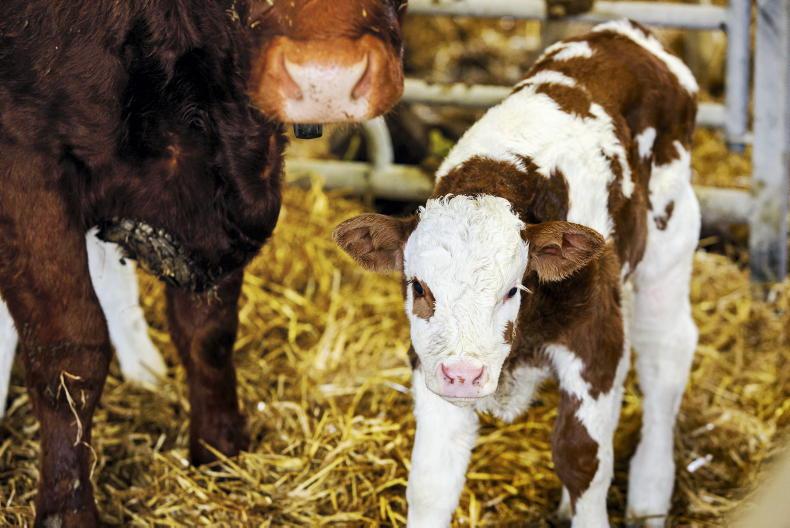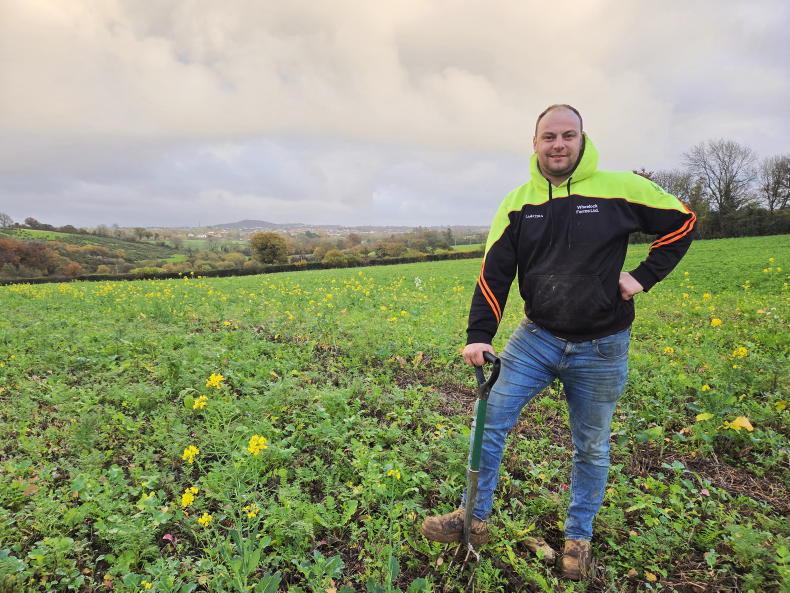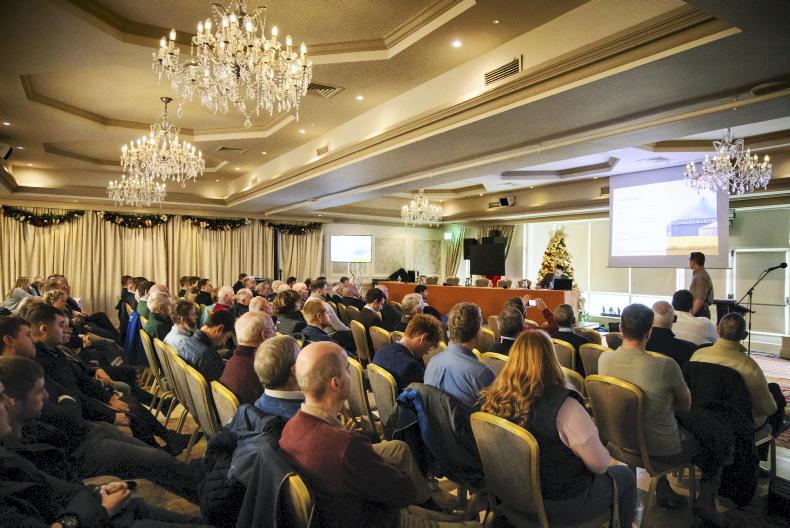At the end of July, suckler and tillage farmer Andrew Mulhare shared his experiences with the Irish Farmers Journal, reflecting on his journey in farming and his active participation in the Footprint Farmers programme so far.
As one of eight participants, Andrew has focused on sustainable farming practices on his 54ha farm in Ballybrittas, Co Laois.
Since joining in 2021, he has adopted eco-friendly methods of farming, invested in biodiversity and improved farm sustainability. Through the programme, he had his slurry, silage and soil tested.
“You can’t manage what you don’t know” is what Andrew says and promoting soil health and nutrients in the most environmental and economical way possible is the goal.
Testing silage was a revelation, showing that appearance alone doesn’t guarantee quality.
ACRES
It wasn’t just the financial support that attracted Andrew to join the Department of Agriculture’s ACRES programme, though it was certainly a significant factor.
Creating spaces for nature is a priority on his suckler and tillage farm. Recently, he established two new riparian buffer zones in corners of fields that were perpetually wet and lead down to drains.
Andrew recalls how his father had fenced off one of these areas during the first REPS scheme.
After getting stuck trying to gather hay from that same corner last year, he realised that going back to a buffer zone would be far more beneficial for that part of the farm.
Andrew’s approach to farming is all about balance. He aims to improve and intensify the productive areas of the farm, while dedicating less productive sections to buffer zones, margins hedgerows and wild bird cover.
This strategy allows him to maximise the potential of his land while contributing to environmental sustainability.
Andrew was lucky to get his cows out by late April, with only slight poaching in the fields. This year was challenging for grazing due to cold weather in May and June, which slowed grass growth, making it tough to keep enough grass in front of the cows.
He was thankful for having fewer cows after selling older ones, but the weather still made it hard to maintain grass growth. This was his first year using protected urea, which he found effective, and plans to apply more before year-end approximately 15 units of N.
With autumn calving, grass is essential. All slurry was applied using LESS, and second-cut silage was done in early August during the fine weather.
Andrew hopes the silage and small amount of hay will be enough for winter, especially when the cows start calving.
The cow collars have helped Andrew to detect cows for bulling much more efficiently.
Andrew has invested in SenseHub collars for his cows, which have proven to be highly effective. These collars monitor the cows’ health, detect signs of bulling and even notify changes in behaviour ahead of the calving date.
Andrew is thrilled with their performance, as all his cows are artificially inseminated (AI) with Simmental, Limousin and Charolais bulls. This technology has helped Andrew to detect which cows are bulling as he works off-farm a few days a week and can often miss the chance for AI.
Since Andrew calves in the autumn, he weans his calves during the summer months. To prevent mastitis, he applies teat sealants – a time-consuming and labour-intensive task but it goes hand in hand with having an autumn-calving herd.
Calving starts around the middle of August and if the weather is fine, the cows will be let out into the fields beside the yard after the calf has sucked.
The calves are weaned in two groups, with both groups already accustomed to eating meal.

The bull weanlings are getting meal before going into the shed for finishing.
Initially, they are brought into the shed for a few days, where Andrew allows them to suck the cows at intervals.
After a few days, the cows are turned back out to the fields, and the weaned calves are moved to a different field of grass.
Meal
The bull weanlings continue receiving meal and are housed in September to be fed and pushed for finishing as 16-month bull beef. Andrew finds that achieving the desired fat score within 16 months is challenging, but the premium price makes it worthwhile and aligns well with his system. It should also result in less methane emissions per kilo of beef.
After weaning, the heifers are left to graze and grow before being fattened at two years old.
Replacement heifers are kept and calve around 30 months, with no rush placed on this process.
Tillage dominates the roads leading to Andrew’s farm.
After seeing the combi crop at the Tullamore Farm open day, Andrew plans to learn more before considering sowing some next spring to reduce reliance on concentrates for weanlings.
He also recently sowed a field of multispecies sward. This was the first year that Andrew has no winter barley but he has winter wheat instead, because it was sown after beans as he is trying to get into a new rotation.
He had both malting and feeding spring barley this year. None of the cereals are kept for feeding to the cattle on the farm.
Andrew had some of the straw in the Straw Incorporation Measure and availed of the funding for baling it as there were many farmers calling him looking for bales.
He will continue to keep a good amount for his own cows and to replenish the stocks after this year’s long winter in the shed.
Farmer:
Andrew
Mulhare.Farm size: 54ha.Enterprise: suckler beef and tillage.Schemes: SCEP, ACRES, Protein Aid Scheme, Straw Incorporation Measure.
At the end of July, suckler and tillage farmer Andrew Mulhare shared his experiences with the Irish Farmers Journal, reflecting on his journey in farming and his active participation in the Footprint Farmers programme so far.
As one of eight participants, Andrew has focused on sustainable farming practices on his 54ha farm in Ballybrittas, Co Laois.
Since joining in 2021, he has adopted eco-friendly methods of farming, invested in biodiversity and improved farm sustainability. Through the programme, he had his slurry, silage and soil tested.
“You can’t manage what you don’t know” is what Andrew says and promoting soil health and nutrients in the most environmental and economical way possible is the goal.
Testing silage was a revelation, showing that appearance alone doesn’t guarantee quality.
ACRES
It wasn’t just the financial support that attracted Andrew to join the Department of Agriculture’s ACRES programme, though it was certainly a significant factor.
Creating spaces for nature is a priority on his suckler and tillage farm. Recently, he established two new riparian buffer zones in corners of fields that were perpetually wet and lead down to drains.
Andrew recalls how his father had fenced off one of these areas during the first REPS scheme.
After getting stuck trying to gather hay from that same corner last year, he realised that going back to a buffer zone would be far more beneficial for that part of the farm.
Andrew’s approach to farming is all about balance. He aims to improve and intensify the productive areas of the farm, while dedicating less productive sections to buffer zones, margins hedgerows and wild bird cover.
This strategy allows him to maximise the potential of his land while contributing to environmental sustainability.
Andrew was lucky to get his cows out by late April, with only slight poaching in the fields. This year was challenging for grazing due to cold weather in May and June, which slowed grass growth, making it tough to keep enough grass in front of the cows.
He was thankful for having fewer cows after selling older ones, but the weather still made it hard to maintain grass growth. This was his first year using protected urea, which he found effective, and plans to apply more before year-end approximately 15 units of N.
With autumn calving, grass is essential. All slurry was applied using LESS, and second-cut silage was done in early August during the fine weather.
Andrew hopes the silage and small amount of hay will be enough for winter, especially when the cows start calving.
The cow collars have helped Andrew to detect cows for bulling much more efficiently.
Andrew has invested in SenseHub collars for his cows, which have proven to be highly effective. These collars monitor the cows’ health, detect signs of bulling and even notify changes in behaviour ahead of the calving date.
Andrew is thrilled with their performance, as all his cows are artificially inseminated (AI) with Simmental, Limousin and Charolais bulls. This technology has helped Andrew to detect which cows are bulling as he works off-farm a few days a week and can often miss the chance for AI.
Since Andrew calves in the autumn, he weans his calves during the summer months. To prevent mastitis, he applies teat sealants – a time-consuming and labour-intensive task but it goes hand in hand with having an autumn-calving herd.
Calving starts around the middle of August and if the weather is fine, the cows will be let out into the fields beside the yard after the calf has sucked.
The calves are weaned in two groups, with both groups already accustomed to eating meal.

The bull weanlings are getting meal before going into the shed for finishing.
Initially, they are brought into the shed for a few days, where Andrew allows them to suck the cows at intervals.
After a few days, the cows are turned back out to the fields, and the weaned calves are moved to a different field of grass.
Meal
The bull weanlings continue receiving meal and are housed in September to be fed and pushed for finishing as 16-month bull beef. Andrew finds that achieving the desired fat score within 16 months is challenging, but the premium price makes it worthwhile and aligns well with his system. It should also result in less methane emissions per kilo of beef.
After weaning, the heifers are left to graze and grow before being fattened at two years old.
Replacement heifers are kept and calve around 30 months, with no rush placed on this process.
Tillage dominates the roads leading to Andrew’s farm.
After seeing the combi crop at the Tullamore Farm open day, Andrew plans to learn more before considering sowing some next spring to reduce reliance on concentrates for weanlings.
He also recently sowed a field of multispecies sward. This was the first year that Andrew has no winter barley but he has winter wheat instead, because it was sown after beans as he is trying to get into a new rotation.
He had both malting and feeding spring barley this year. None of the cereals are kept for feeding to the cattle on the farm.
Andrew had some of the straw in the Straw Incorporation Measure and availed of the funding for baling it as there were many farmers calling him looking for bales.
He will continue to keep a good amount for his own cows and to replenish the stocks after this year’s long winter in the shed.
Farmer:
Andrew
Mulhare.Farm size: 54ha.Enterprise: suckler beef and tillage.Schemes: SCEP, ACRES, Protein Aid Scheme, Straw Incorporation Measure. 










SHARING OPTIONS